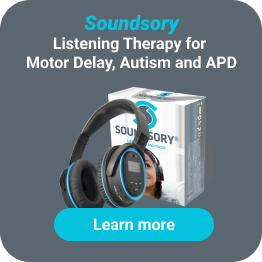Free Guide | Oral Motor Exercises and Taste Sensory Activities for Children
 Rebecca Huxley
Rebecca Huxley Physiotherapist
December 18, 2023
Introduction
Oral motor exercises are exercises for the mouth, lips, jaw and tongue. There are plenty of reasons to make oral motor exercises and taste sensory activities a part of your child’s therapy plan. This is especially true for children with autism, Attention Deficit Hyperactivity Disorder (ADHD), or sensory processing disorders.
In this article, you’ll learn about the importance of oral motor and taste exercises for children with specific developmental needs. These exercises can help your child with speaking and articulating words better, and can make meal times less challenging.
We’ll cover some fun and practical ways to encourage your child to engage with these exercises, making them effective and enjoyable. You’ll learn eight specific oral motor exercises, presented in original, modified, and simplified versions for different needs. We’ll also provide insights into taste sensory activities, focusing on texture, taste, and temperature, to encourage diverse dietary experiences.
Additionally, we will discuss the Soundsory® program and how it complements oral motor exercises for holistic child development. Soundsory® is a 40-day program that can boost kids’ neurodevelopment. The program pairs enhanced rhythmic music with holistic, whole-body exercises.
How can oral motor exercises and taste sensory activities help with mealtimes?
For children with sensory issues, mealtimes can be a very difficult time for both you and your child. You may worry that they’re missing out on key nutrients if they refuse to eat certain types of food, and your child may become stressed if they feel pressured to eat foods they’re not used to.
On the other hand, your child may be willing to try new foods, but you might have concerns that they are struggling to chew their food properly. They may be excessively messy, and often miss their mouth. Children with ADHD may struggle to sit still long enough to eat a full meal – repetitive chewing can be considered boring and they may dislike mealtimes.
Taste sensory activities can turn mealtimes and snack times into a fun game. You can use play to encourage your child to keep eating for longer and to try new foods, in a way they enjoy. Oral motor exercises build the foundational skills needed to chew properly and keep food in their mouth.
Key Take-Away Messages
| Why use oral motor exercises and taste sensory activities for children? |
| Oral motor exercises (exercises for the mouth, lips, jaw and tongue) and taste sensory activities are very important for children who have autism, ADHD, or sensory processing difficulties. Here’s a few of the things these exercises can help your child with: Language skills and articulation (forming words and sounds) Chewing food properly Swallowing food at the right time Trying new foods Keeping food in their mouth while chewing Reducing stress for you and your child at mealtimes Brushing their teeth |
Try Soundsory®, a unique blend of music and movement therapy, to enhance your child’s neurodevelopment.
What are oral motor exercises?
Oral motor exercises are exercises to improve the strength, coordination and mobility of the tongue, jaw, lips and mouth. They can help your child to develop the coordination needed to properly form words and sounds (articulation).
They can also help to improve skills like brushing your teeth and manipulation of food, which refers to chewing and swallowing food and liquids, moving food and liquids within the mouth, and tolerance to various textures.
Do oral motor exercises actually work?
Research says they do. One study gave young children a four-week oral motor therapy program. The program was targeted towards age-appropriate feeding and swallowing. They found that the children’s speech and articulation improved after the program, indicating a link between eating skills and speech. [1]
Another study tested oral motor exercises with children who had cerebral palsy and moderate eating difficulties. After 10 weeks, the kids’ eating, spoon feeding, chewing and swallowing skills improved. [2]
Make it fun
As helpful as oral motor exercises may be, your child will only want to take part if it’s enjoyable for them in some way. The best way to do this is to make the exercises fun, so your child looks forward to doing them.
If you can make the exercises into a game, it will be much more fun for your child and they’ll be more likely to engage. One way to do this is playing ‘Simon Says’ with the exercises, if this is something your child’s able to do.
You could also try playing the hokey-pokey with your tongue and cheeks to encourage your child to do the exercises. You can use teething toys to explore different textures, or use a straw to pick up pieces of paper and drop them in a bowl, or whisper-sing the alphabet song together. Stay safe – don’t give your child any small objects that would be harmful if swallowed.
While you’re playing these exercise games with your child, you could take the opportunity to add in eye exercises (link to sister page), fine motor finger games to improve dexterity, or tactile exercises to get used to different textures. The more fun your child has, the more likely it is they’ll want to do the exercises again.
How often should your child practice oral motor exercises?
Kara Tavolacci, SIPT certified Occupational Therapist, answered this question.
“How long and how often to do any exercise is often a question that gets asked. As with all exercises, the more intense and frequently you do them, the quicker you are to see changes. That being said, everyone is different, everyone has different capacities and different goals they may be working on.”
“Younger children will have shorter attention spans, so you might do less repetitions but more frequently throughout the day or week. Older kids may be able to handle more repetitions and for longer periods of time. There are really many ways to introduce oral motor exercises. They can be easily introduced and incorporated into daily routines by completing them prior to meal time.”
Kara also gave a couple of signs that it may be time to stop an exercise:
- If your child has mastered the exercises or improved in the skill you were targeting.
- Fatigue or burnout; if your child complains about the exercise and avoids doing it. With any exercise, you can always take a break and then circle back to it. That’s the great thing about the flexibility of exercises.
Eight oral motor exercises for toddlers and kids
We’ve gathered eight of the best exercises to help improve your child’s oral motor skills. You can use these to create fun games to play with your child and make it more interesting, but these are the basic movements to include. These don’t require any special equipment, it can be just you and your child. A mirror can be helpful for the simplified versions.
We’ve included three versions of each exercise:
- Original: instructions for you to give to your child
- Modified: instructions for you, the parent, to assist your child
- Simplified: instructions for you to assist your child further
- Open and close mouth
- Original: Open and close your mouth. Repeat this five times, pausing in between each one.
- Modified: Use gentle tactile cues to guide your child’s jaw open and closed.
- Simplified: Use a mirror, tactile cues and parent modeling to encourage your child to open and close their mouth.
- Puff cheeks out
- Original: Puff your cheeks out.
- Modified: Use tactile cues to encourage your child to puff their cheeks out.
- Simplified: Use a mirror, tactile cues and parent modeling to encourage your child to puff their cheeks out.
- Kiss lips
- Original: Bring your lips into a kissing shape
- Modified: Use tactile cues to encourage your child to purse their lips into a kissing shape.
- Simplified: Use a mirror, tactile cues and parent modeling to encourage your child to purse their lips into a kissing shape.
- Fish lips
- Original: Make your lips look like big fish lips (you can show your child a picture of a fish with big lips).
- Modified: Use tactile cues to encourage your child to do fish lips.
- Simplified: Use a mirror, tactile cues and parent modeling to encourage your child to do fish lips.
- Lick lips
- Original: Practice licking along your top and bottom lips
- Modified: Use tactile cues to encourage your child to lick along their top and bottom lips.
- Simplified: Use a mirror, tactile cues and parent modeling to encourage your child to lick along their top and bottom lips.
- Stick tongue out
- Original: Stick your tongue out.
- Modified: Use tactile cues to encourage your child to stick their tongue out.
- Simplified: Use a mirror, tactile cues and parent modeling to encourage your child to stick their tongue out.
- Stick tongue out move side to side
- Original: Stick your tongue out and move it side to side.
- Modified: Use tactile cues to encourage your child to stick their tongue out and move it side to side.
- Simplified: Use a mirror, tactile cues and parent modeling to encourage your child to stick their tongue out and move it side to side.
- Stick tongue out move up and down
- Original: Stick your tongue out and move it up and down.
- Modified: Use tactile cues to encourage your child to stick their tongue out and move it up and down.
- Simplified: Use a mirror, tactile cues and parent modeling to encourage your child to stick their tongue out and move it up and down.
Taste sensory activities for children
Taste exercises are less of a formal task, and more something to think about through the day during meal and snack times. The key areas to focus on with food are texture, taste and temperature.
Helping kids talk about these aspects can help them understand the differences between foods, and maybe even try new foods. It’s important to have conversations about your snacks like ‘oh, my snack is lumpy, and yours is crunchy’. This can highlight differences between food and help get away from the yucky/yummy battle.
Here are some texture, taste and temperature ideas to get you started:
| Texture | Taste | Temperature (food/drinks) |
| Crunchy Crisp Smooth Lumpy Uniform lumpy (cottage cheese) Hard Chewy Mixed | Salty Sweet Spicy Tart /sour Flavored Bland | Hot Warm Cold Cool |
It’s also great to get your child eating munchy, crunchy foods and chewy foods to get used to these different textures and tastes.
Munch crunch types of foods: Apples, carrot sticks, Cheerios, chips, corn chips, corn curls, Graham crackers, granola, pickles, pretzels, popcorn, raw veggies.
Chewy foods: bubble gum, cheese, dried fruits, french fries, fruit roll ups, gummy bears, gummy worms, jerky, lemon drops, licorice sticks, long suckers, marshmallows, oranges, Slim Jims, raisins skittles, sugarless gum.
Conclusion
Oral motor exercises and taste sensory activities are a great way to help your child’s development. Speech and eating skills are closely linked, and as one improves, the other often does too. For a holistic approach to improving your child’s development, try Soundsory®; the 40-day program that pairs whole-body movement exercises with enhanced rhythmic music.
FAQs
References
- Kollia, B., Tsiamtsiouris, J., & Korik, P. (2019). Oral motor treatment: Effects of therapeutic feeding on articulatory skills. Journal of Prevention & Intervention in the Community, 47(1), 14–24. https://doi.org/10.1080/10852352.2018.1547305
- Gisel, E. G., Applegate-Ferrante, T., Benson, J., & Bosma, J. F. (1996). Oral-motor skills following sensorimotor therapy in two groups of moderately dysphagic children with cerebral palsy: Aspiration vs nonaspiration. Dysphagia, 11(1), 59–71. https://doi.org/10.1007/bf00385801



